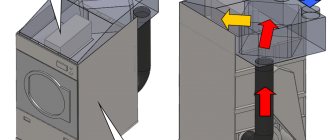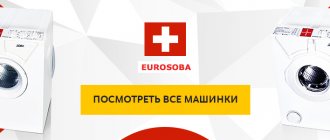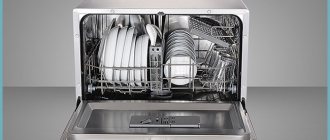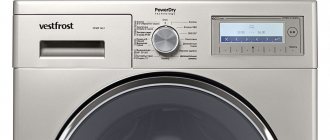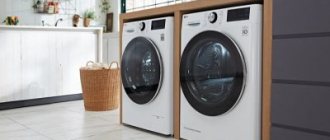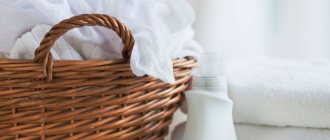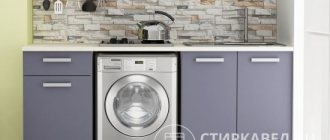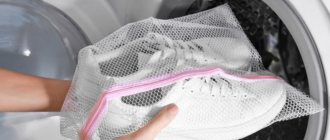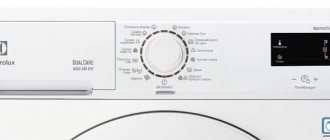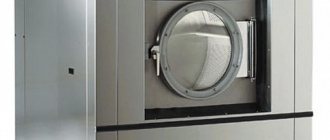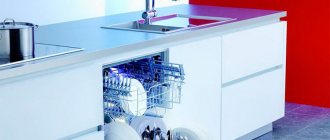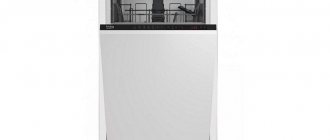15 Jul 2021
11183
What types of dryers are there? What is the difference between separate and combined washer-dryer models? We analyze the types of drying machines and the main selection criteria.
- Advantages of a dryer
- Dryer or washer dryer
- Principle of operation
- Main selection criteria
- Determining the maximum load
- Selecting the spin speed
- Understanding the type of control
Washing and drying machine in the interior
It is worth taking a closer look at the drying machine if the apartment has high humidity or does not have a balcony or other convenient place for drying clothes. A couple of hours - and the washed clothes are dry, and there is no laundry hanging around the house. Some models have a steam treatment function - you can clean soft toys from dust or fluff up pillows.
Advantages of a dryer
In addition to keeping things dry, the dryer has a number of other useful options:
- Dries quickly - no need to wait all day to make room for drying a new load of laundry.
- Saves time on hanging laundry.
- Takes up less space than hanging structure.
- Dry laundry is softer than when dried naturally - towels and woolen clothes become soft and airy, as if they were just purchased.
- Most items do not need to be ironed after drying.
- Removes lint, pellets and pet hair from clothes.
- There is no need to dry-clean down jackets or sleeping bags - after drying, the down does not bunch up and keeps its shape perfectly.
- You don't have to wait all day for your wool sweater to dry naturally—the machine will do the job in two hours.
- Quick and gentle drying of shoes (with a special basket).
- If things have acquired a stale smell, they can be refreshed without washing.
Dryer or washer dryer
There are two types of dryers: free-standing and combined - combined with a washing machine.
Combined washer-dryers can have one drum, or they can have two: you can wash in both drums, and also dry in the lower one
Single drum washer-dryer models
suitable for those who do not have free space to install another device and who are not willing to pay for two machines instead of one. Things are washed and dried in one drum.
This also solves the problem of complex installation of one machine on another. If you buy a washing machine and dryer separately and decide to install them in a column, you will need a plastic adapter, which is not always easy to find and select.
Models with two drums
take up more vertical space, but allow you to simultaneously wash two different categories of items: outerwear in one drum, underwear or black and white in the other. This allows you to save time on washing. The drying function is available in the lower drum.
Freestanding dryers
- two machines that are in no way connected with each other. They can be installed on top of each other, side by side, and even in different rooms.
Differences between budget devices and premium and mid-range devices
from expensive electrical appliances for drying clothes and models from the mid-price segment in their range of functions, number of programs and design .
a dryer often depends on the reputation of the manufacturer , which has been producing its products for many years or has recently appeared on the household appliances market.
Having studied the cost of dryers from different price categories, we can draw the following conclusions:
- the average price of budget models is 20,000 – 30,000 rubles;
- you can purchase a device from the mid-price segment for 35,000 – 50,000 rubles;
- expensive devices will cost the buyer approximately 60,000 - 75,000 rubles.
Principle of operation
The drying process depends on the design of the device.
The dryer can be:
- ventilation;
- condensation;
- with heat pump.
In ventilation
The laundry is dried with a fan - like in the wind. The moist air generated after loading laundry is blown out through the opening. A flexible air duct is connected to it, which must be ducted into the ventilation or out the window, otherwise mold or mildew may grow in the apartment.
In condensation
The air heats up and enters the drum; under the influence of temperature, the moisture begins to evaporate. Condensation forms on the surface of the tank, which flows either into the sewer or into a plastic tank, from which water is then poured out manually. The dryer takes in air again and the cycle repeats.
Equipment with a container for moisture removal can be installed anywhere, without being tied to a sewer system, for example in a corridor. If there is no such reservoir, the dryer is connected like a washing machine - the hose is routed to the drain, sink or toilet.
Such a device must constantly condense warm air and cool the washing machine tank, so water consumption is always greater than in models with a heat pump
.
Heat pump machines
— an improved type of condensation. The air is not thrown out, but enters the cooling compartment, and then again into the drum. The air does not cool down too much, and reheating occurs faster and with less energy consumption. The device does not waste energy on constant air intake. This closed drying cycle saves up to 50% energy.
Such machines are an excellent choice, but due to their complex design they are more expensive than ventilation or conventional condensing machines.
Creating the right conditions
Drying refers to the removal of residual moisture after the washing and spinning procedure. A universal method of hanging on a balcony or in an apartment is suitable for most types of clothing.
To keep your laundry fresh, a number of requirements must be met:
- the higher the air temperature, the faster the moisture will evaporate from the surface of the fabrics;
- low hanging density promotes rapid drying;
- active air circulation significantly speeds up the process.
Many city residents use batteries during the heating season. Linen dried in this way acquires rough creases and is difficult to further iron. If it is not possible to dry outdoors, it is recommended to use floor-mounted folding devices. During the drying process, the room must be thoroughly ventilated. Prolonged stay in a damp state contributes to the appearance of a musty smell from the laundry.
Main selection criteria
The following parameters influence the choice of dryer:
- Installation location.
- Number of things.
- Electricity consumption.
- Additional functions.
Load Type
By the type of laundry loading, most dryers are front dryers; items are placed in them through the door at the front. There are few freestanding top-loading dryers, mostly washer-dryer models.
Advantages of front loading:
- Large selection of sizes - from standard to extra-narrow.
- The surface can be used as a shelf.
- Can be built under a countertop or installed on a washing machine.
Pros of vertical loading:
- There is no need to bend over to load or unload the dryer if it is installed on the floor.
- Can be installed in a space where there is no room to open the door from the side.
Device dimensions
Before choosing a dryer, decide where it will be installed. If you plan to place it in a column with a washing machine, look at the options from the same manufacturer, as in this case it will be easier to find a mount. If the appliances are from different brands, the dryer should not be larger than the washing machine. Ideally, their widths should match.
If the dryer will be placed separately, you need to measure the space where it will stand. Consider the gaps: 5-10 centimeters from the back panel to the wall and at least 1 cm on the sides.
Most freestanding drying models have a height of 84 to 90 cm, a width of 60 cm or more, but the depth varies:
| Depth (cm) | |
| Standard | 60 or more |
| Narrow | 50-59 |
| Ultra-narrow | 40-49 |
It is rare, but there are compact drying machines up to 50 cm wide, which can load no more than 3 kg of laundry.
Drum volume
All laundry washed in one cycle in the washing machine must be placed in the dryer. In order for it to dry evenly and not wrinkle, there should be enough free space in the drum - approximately 16 liters per 1 kg of laundry. Therefore, when choosing a separate dryer, keep in mind that the drum volume is larger than that of your washing machine. The standard recommendation is 100-110 liters.
Loading weight
The maximum load weight is the weight of dry items, not wet items. This figure usually applies to cotton and linen fabrics, but the weight for synthetics and mixed fabrics will be different. Manufacturers indicate this in the specifications. For example, for cotton the loading weight is 8 kg, and for synthetics it is 3.5 kg.
The maximum load weight of the dryer can be from 3.5 to 11 kg. The optimal figure for a couple is from 4 to 6 kg, for a family of 3-4 people - from 6 to 9 kg. For a family of 5 or more people, it is better to choose a model with a load of 10-11 kg.
Haier washer-dryers can take from 4 to 6 kg of laundry in drying mode and save space:
At the same time, the dimensions of machines with an increased drying volume are small, allowing you to save space
Machines with vertical loading usually have standard dimensions: height - 85 cm, width - 40 cm, depth - 60 cm.
Rating of advanced devices
SIEMENS WT47Y782OE
Price ~ 94,000 rub.
A beautiful, ergonomic dryer with a set of all necessary modes and functions. Touch control and backlight mode make working with it as convenient as possible.
Characteristics:
- Type – condensing.
- Maximum load – 9 kg.
- Energy consumption class – A++.
- Drum volume – 112 l.
- Number of modes – 16.
- Tank material – stainless steel.
- Power – 1000 W.
Pros:
- internal lighting;
- digital display, electronic control;
- ironing mode, according to the type of fabric, clothing.
Minuses:
- not identified.
“It’s an excellent machine, it dries well and doesn’t make much noise. It does a great job of removing fabric dust from things, and sleeping on pillows has become noticeably more pleasant.”
SMEG DHT83LRU
Price ~ 70,000 rub.
This model is distinguished by its impeccable design and the absence of unnecessary details. With a very capacious drum, it consumes extremely little electricity.
Characteristics:
- Type – condensing.
- Maximum load – 8 kg.
- Energy consumption class – A+++.
- Number of modes – 16.
- Tank material – stainless steel.
- Power – 800 W.
- Noise level – 65 dB.
Pros:
- interior lighting;
- digital display, electronic control;
- mode according to the type of fabrics, clothing.
Minuses:
- not identified.
ELECTROLUX EW6CR428W
Price ~ 50,000 rub.
Quite a popular aesthetic model in the mid-price category. Its main advantage, which is often shared in reviews, is its noiselessness.
Characteristics:
- Type – condensing.
- Maximum load – 8 kg.
- Energy class – B.
- Drum volume – 118 l.
- Tank material – stainless steel.
- Power – 2250 W.
- Noise level – 65 dB.
Pros:
- humidity control;
- Heat pump;
- digital display, electronic control;
- types of fabrics and clothing are taken into account.
Minuses:
- not identified.
“We have never regretted it, things are soft after it, as if they had been steamed in a dry cleaner, and most importantly, they don’t have to be hung on the dryer, which takes up half the room.”
GORENJE DA82IL
Price ~ 45,500 rub.
Convenient, economical model with an improved lint removal system. Pleases with a rich set of functions for a relatively low price.
Characteristics:
- Type – condensing.
- Maximum load – 8 kg.
- Energy consumption class – A++.
- Number of modes – 14.
- Tank material – stainless steel.
- Power – 800 W.
- Noise level – 65 dB.
Pros:
- humidity control;
- Heat pump;
- digital display, internal lighting.
Minuses:
- not identified.
Determining the maximum load
It is important to pay attention to one of the main characteristics of washing machines - the maximum load of laundry. This is the weight of dry items you can wash at one time. Overweight can increase drum vibrations during spinning, which can lead to rapid wear of internal mechanisms and machine breakdown.
Maximum load options:
- 3–4 kg - for a person who lives alone. A washing machine with this load capacity is also suitable for those who wash clothes almost every day in small quantities.
- 5–6 kg - for a family of two or three people.
- 7–9 kg - for a family with two children.
- 9–12 kg - for large families and people who do a lot of laundry in large batches.
If you wash pillows, blankets, blankets and bulky clothes yourself, you should take a closer look at models with a large drum. At the same time, the machine does not have to be full-size: it can be narrow, but with increased height.
Haier's line of washer dryers includes Super Drum models with a wide hatch and increased drum capacity for convenient loading of large items.
Some modern machines can weigh a load of laundry. The device will tell you if you overload it. All Haier models have an auto-weighing function.
Popular manufacturers
Remember! Many popular manufacturers of household appliances offer customers functional models of dryers.
It is quite difficult to choose just one device, so it is worth checking out the list of the best brands and designed electrical appliances that have become the best-selling ones. Among them:
- Bosch. A leading German brand under which various household appliances are produced, known for their reliability, quality of assembly and materials, as well as high technical characteristics. From the many models of drying machines offered by the manufacturer, experts highlight:
- WTW85469OE;
- WTH83000OE;
- WTW876H0OE;
- WTM83260OE.
- Gorenje. A Slovenian company that is one of the seven best manufacturers of home appliances. Users especially liked such multifunctional devices from Gorenje as:
- DS94ILS/I;
- DE82;
- DA82IL;
- D98F65F.
- Electrolux. The largest Swedish manufacturer of household and professional appliances, which has won the trust of customers with high-quality products. The best Electrolux drying machines are:
- EW6CR527P;
- EW6CR428W;
- EW8HR258B;
- EW9W161B.
- Hotpoint-Ariston. An Italian company that has been producing large and small household appliances for many years. The leading positions in the ratings are occupied by the following models of drying machines:
- FTCD 97B 6H (EU);
- AQC94F5T/Z1;
- WDG862;
- AQC9BF7TEU.
- Beko. A Turkish company that has established itself as a high-quality, reliable and affordable brand. Among the variety of devices developed by the manufacturer, the following models stand out:
- DU7111PA;
- DS8433RX;
- DPS 7205 GB5;
- DB7111PA.
- Siemens. A German concern specializing in the production of electronics, home appliances and medical equipment. According to the owners, several functional models deserve increased attention:
- WT45W561OE;
- WT45RV20OE;
- WT47Y782OE;
- WT47W561OE.
Selecting the spin speed
In modern washing machines, spin speeds can reach 2000 rpm. The higher the speed, the more energy the machine consumes and the drier the laundry after finishing washing.
Each machine has its own spin class, it is designated by a letter and indicated in the technical specifications.
- "G" and "F" are the lowest grades. The maximum speed is 400 and 600 rpm, respectively, things remain almost completely wet.
- “E” - up to 800 revolutions, clothes dry by 25%.
- “D” - up to 1000 rpm, laundry is spun by 30%.
- “C” - up to 1200 revolutions, the laundry is half dry.
- “B” - up to 1400 rpm, 45% of moisture is removed from clothes.
- “A” - from 1600 to 2000 rpm, things dry almost completely.
To determine what spin speed you need, you will have to analyze what you are washing. For example, if your wardrobe is dominated by clothes and bedding made of cotton and natural fabrics, it is recommended to wash them at a spin speed of up to 1000 rpm. If you use things made of different materials, choose a machine with the ability to adjust the spin cycle.
Understanding the type of control
Washing machines have two types of control - mechanical and electronic.
Mechanical machines have from 3 to 5 washing programs, for example “Cotton”, “Synthetics” and “Delicates”. Water temperature, spin speed and other parameters must be set manually using buttons and switches. The machine notifies you of the end of the wash cycle with a sound signal and can turn off automatically. Prices for such equipment and its repair are lower.
Electronically controlled models have software that independently adjusts the parameters. The entire process is accompanied by sound signals. Machines are most often equipped with touch screens, where you can set additional settings and monitor the progress of the wash.
Haier uses electronic control type. Options for setting up the washing machine and the washing process are displayed on a large backlit LED display; the operating mode is controlled by the usual rotary switch (for example, on the HW80-B14979S model).
Energy efficiency class: from best to worst
Power
The power consumption of the dryer affects the energy consumption. The lower it is, the more economical the equipment will be. You can view the characteristics in the equipment passport or on the sticker on the back panel. The optimal indicator is 1.5-2.3 kW. Devices with a power of 4 kW create a large load on the network, consume a lot of electricity, and cannot always be connected in an apartment due to the wiring features.
Programs
Having the right programs is an important parameter when choosing a dryer. It’s good if it allows you to dry it “under the iron” - the laundry remains slightly damp, so it’s easier to iron. This mode is used if, for example, you want to iron shirts after drying.
Some fabrics cannot be dried at high temperatures. If you have clothes made of silk, lace or with appliqués, pay attention to the presence of a delicate drying mode.
Additional functions
Different manufacturers have different names, but the essence is similar.
- Touch detection of laundry humidity - temperature, steam intensity and processing time are selected automatically.
- Reverse rotation of the dryer drum prevents creasing.
- Steam refreshing - to eliminate unpleasant odors from things that do not need a full wash.
- Drum lighting for easy loading.
- UV lamp - for disinfecting things when drying.
- Child protection.
- Flavoring things.
- Sensor for drum loading level and drain fullness.
- Indicator that the filters are full of dust.
- Delayed start - the ability to start drying things at a convenient time, for example at night, when the electricity tariff is lower.
- Cooling at the end of the drying cycle - to prevent the formation of creases and deep wrinkles.
- Push notifications to your phone after the drying cycle is completed.
- Memorizing individual programs - so as not to configure each time.
- Removable housing cover for ease of installation.
- Digital display - displays the time remaining until the end of the cycle.
- Sound indication that indicates the completion of drying.
- The presence of additional baskets, for example for placing shoes or plush toys.
There is no need to chase all the functions at once; it is important to pay attention to which ones you really need and not overpay for unnecessary things when purchasing.
Features of installing a dryer
Once you have chosen a machine, think about how you will install it. It is better to use the help of specialists. When installing washing and drying equipment in a column, be sure to use a special mount. If installed incorrectly, you may be denied warranty repairs if something breaks. Such a mount may be included with the equipment; if it is not available, buy it separately. Carefully read the operating instructions, which indicate exactly how the equipment should be installed.
Additional drying methods
With a towel
One of the most versatile ways to speed up the drying of items that cannot be tumble dried is to spin them again with a clean towel. During torsion, the loose fabric will absorb the maximum amount of residual moisture, after which things will dry much faster.
The method may also be suitable for some delicate products for which spinning is prohibited. In this case, the item is carefully folded, wrapped in a towel and placed in a fabric bag of a suitable size. Then press at minimum speed.
To manually spin woolen products, they are laid out on a clean, dry towel and rolled up with a roller. Then, with little effort, roll it in different directions.
Excess moisture is intensively absorbed. If necessary, the procedure can be repeated. After preliminary removal of the liquid, the item is dried in the recommended way.
Using an iron
The easiest way to finish drying an item is to use high temperatures, but be sure to read the manufacturer’s ironing recommendations. If you do not wait for the product to dry completely, you can avoid the appearance of difficult to remove folds and creases. Ironing semi-dry items is comparable to intensive steaming. This removes any remaining liquid and gives the clothes an ideal appearance.
When using the iron for very damp items, it is recommended to place a thick terry towel underneath. When heated, the rate of water absorption will increase significantly, and the item will dry much faster. The steam function must be completely turned off. Particular attention should be paid to seams and tighter areas. During the ironing process, it is advisable to let the product cool on a hanger several times to speed up drying.
Also, many people ask the question, how to dry at a low temperature? For drum drying, this is the minimum value setting; for natural drying, heating devices are prohibited. Small and thin items can also be exposed to air flows from fans and air conditioners. Small tricks in everyday life will make life easier for a young housewife.
